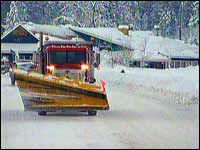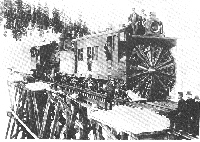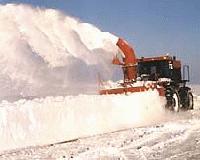 |
 |
| Home | Welcome | What's New | Site Map | Glossary | Weather Doctor Amazon Store | Book Store | Accolades | Email Us |
 | |||||||||
Weather Almanac for December 1999Moving The Snow With the coming of winter, one of the major concerns of all municipalities and the transportation industry becomes snow removal. Snow and ice are the greatest hindrances to our vast transportation network across almost all of North America. They delay air and rail transportation and can bring road traffic, the bloodline of all urban areas, to a complete halt, often for days. And snow removal does not come cheap. Montreal, for example, budgets over $C60 million each year for snow removal operations within the city. For most of the history of North America, however, snow removal was not of great concern. In fact, quite the opposite was often the case. In the days of horse-drawn vehicles keeping snow on the unpaved roads during the cold months was the prime focus. Eric Sloane, artist, writer on early Americana and weather aficionado, tells us in his books on 18th and 19th century life in New England that "snow was never a threat but rather it was an asset to the average road traffic..." A road surface of well-packed snow was a god-send to many farmers who were now able to transport heavy loads like timber and stones on sleds with comparative ease. Sleds and sleighs were not the recreational items they are today, but the equivalent of the modern pick-up truck or four-wheel drive vehicle. To facilitate winter transportation, many northern communities used snow rollers to pack down the snow, thus making the road smoother and the snow surface longer lasting than an ungroomed snow surface. Indeed, winter road work in the 19th century was more akin to today's grooming of ski hill than current winter road maintenance practices. Snow rollers were large, single wide-wheeled vehicles with logs or rocks as ballast to give it weight, usually pulled or pushed by a team of oxen. They were operated by men employed by the community as snow wardens. Their critical job was to pack the snow upon local roadways and fill in melted or otherwise bare spots to keep sleds and sleighs moving with ease. One of the snow warden's most laborious jobs was to "snow-pave" the deck of covered bridges so that traffic could pass over them. According to Sloane, although snow was frequently gone from the woods and fields of the countryside by the end of March, it often remained packed on the roads -- the successful efforts of the local snow wardens. In the 1840s, the first snow plows were designed and patented but more than a decade would pass before the plow designs were put to use clearing urban streets. In 1862 Milwaukee became the first major municipality to use a snow plow. The plow was attached to a cart pulled by a team of horses through the snow-clogged streets. Over the next several years, such horse-drawn plows gained popularity and came into use in many Northern and Eastern cities. While plowing cleared the main streets for traffic, it effectively blocked the side streets and sidewalks with huge, uneven mounds of compacted snow. Businessmen and merchants, who initially hailed the success of street plowing, later objected to the practice and even brought lawsuits against the plowing companies, claiming their storefronts were completely blocked by mounds of plowed snow and thus making them inaccessible to their customers. Townsfolk struggling to negotiate the huge mounds which often obstructed the sidewalks complained loudly at the inconvenience. New York and other cities eventually responded to the complaints. They hired shovelers and horse-drawn carts to work in conjunction with the plows to haul away the plowed snow. This not only cleared the unwanted mounds of snow, but provided thousands of seasonal jobs.
One interesting new snow removal concept was the Barber-Green snowloader, first successfully tried in Chicago in 1920. Riding on tractor treads, the snowloader was equipped with a giant scoop and a conveyor belt. As the snow was plowed, it was forced up the scoop and onto the conveyor belt which carried it up and away from the street, finally depositing the snow into a chute where it was dropped into a dump truck parked underneath. Another successful innovation in snow removal is today one of the most popular: the rotary snowplow or, in today's language, the snow blower. The initial design arose from the need to clear railroad tracks of snow. For its story, let us jump in time and space across the continent to the Canadian West of the 1880s. Canada, like the United States, is a vast and wide nation that was finally linked from coast to coast in the 19th century by the great transcontinental railroads. When the rails at last traversed the western mountain ranges, Prairie grains and other resources finally had an outlet to lucrative Pacific markets. Crossing the parallel mountain ranges of the Canadian West in summer was difficult enough, but for half the year, the Canadian Rockies were firmly in the grip of Ol' Man Winter who often halted the flow of rail traffic by burying the tracks under heavy snows and avalanches. The first railroad snowplows used in the East and on the Prairies were built like a wedge, a large variation of the cow-catcher that pushed the snow to either side of the track. However, their use in deep, heavy snow or avalanche areas had serious drawbacks. Wind-packed drifts or snow slides mixed with rock or timber could cause the plow to jump the track, a dangerous situation in the mountains where tracks frequently clung to mountainside ledges. The solution came from the engineering designs of four Ontario men. The basic patent for the rotary snowplow was awarded to J.W. Elliott, a Toronto dentist in the 1870s. Its design was very similar to today's snow blowers -- a rotary engine that drives a wheel on which flat plates were attached to the rim. The snow was collected from the track by a housing that funneled the snow to the revolving blades. The motion of the blades then threw the snow out an opening at the top of the housing. Elliott, however, could not interest the railroads in his invention at the time, and the concept languished for many years. A decade later, Orange Jull modified the Elliott design to include a cutting wheel located in front of the throwing wheel. Jull then persuaded the Leslie brothers of Orangeville, Ontario to construct a full-scale working model. The first test of the Jull-Elliott rotary snowplow came during the winter of 1883-84. A deep bank of ice and snow was especially shoveled onto the tracks at the Canadian Pacific Railroad shops in Toronto. The plow, mounted on a flat car, successfully tossed snow and chunks of ice as much as 200 feet from the tracks. But the tests suggested further improvements were necessary. Two major modifications were made after the initial Toronto field test. First, an ice-cutting flange was added to the housing to remove all obstacles from the track and to prevent the unit from being derailed in packed snow. Then a reversible knife was incorporated to allow the operator to toss snow to either side of the track. This new design was built in the Cook locomotive works in New Jersey and field-tested during the winter of 1885-86 on the northern Iowa tracks of the Chicago and Northwestern Railroad. The new design with contra-rotating wheels required excessive power to run and tended to clog easily with snow. The next model design incorporated a single wheel equipped with vanes that were capable of reversing their angle with a change in the wheel's rotational direction. The Union Pacific Railroad successfully tested this version in Oregon the following winter and ordered four units on the spot.  The Canadian Pacific Railroad introduced eight rotary plow units to Canadian routes in 1888. The largest of these -- Number 101 -- had a plow wheel diameter of 10 feet driven by a main shaft 8.5 inches across. But even Number 101 was inadequate for the snow conditions the Rockies threw at it. The rotary plow worked well in dry Prairie snow, but in the wet, packed snows of the West Coast, the snow-throwing flange performed poorly. To overcome this, the Leslie Brothers increased the plow wheel diameter to 11 feet, designed a scoop wheel to replace the square-fan collector and added cut wideners to the housing. This design proved so successful that it changed little over the next century. With its introduction in the Rockies, the Western Canadian rail routes could now operate year round.  Heavy snows continue to immobilize and paralyze a city, stranding commuters, stopping the flow of supplies, and disrupting emergency and medical services. But the rotary snowplow leads the assault on major winter snow storms. Today, the smaller descendants of Number 101 can be found in public and private garages across North America as the snow blower. In its various forms, the snowblower can be found clearing snow from roads, sidewalks and even airport runways and taxiways, its characteristic rooster-tail plume of snow shooting into the wind, a familiar urban sight in winter. Learn More About Snow From This Relevant Book
|
|||||||||
 |
To Purchase Notecard, |
Now Available! Order Today! | |
 |
 |
NEW! Now |
The BC Weather Book: |


